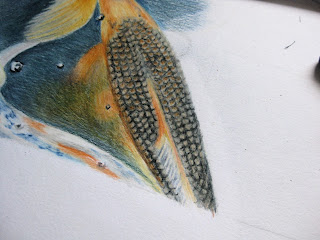I sketch in a small fish using orange chrome, highlighting an area along the fish's back in a deep yellow (gold). I subsequently blend the two colours well into each other and the grain of the paper using the stumper.
I then apply a layer of deep chrome (orange) around the parts of the fish which are lower in the water.
Again the colours are blended together with the aid of the stumper and some Chinese white. Along the lower flank I add some fell grey and gunmetal grey where there is shadow from the larger fish swimming nearby.
Two more fish get the same treatment at the top of the picture and the surrounding water is quickly drawn in with the usual sequence of colours.
I move to a large area of water to the right of these two fish, applying the same layers of colour and making sure to blend them well with the stumper as I work.
It's important to step back from time to time while drawing and look at both the photo you are drawing from and the drawing itself.
I see that I need to add some "floating bits" so that the water looks more realistic when it's finished. Taking the eraser I erase a few small "dots" here and there on the surface of the water. It's not necessary that these should be totally white, but they do need to be lighter than the water itself. They also need to be emphasised and to have depth, so I take the ivory black and apply shadow along the lower edges. Here it's vital to put the shadow on the same side of each dot so that the fall of light is from the same direction or things will look very odd!
Another couple of fish are (semi-) completed in the same way. I should mention that before applying coloured pencil in any area of the drawing I always make sure the paper is very clean. Using the eraser I erase all non-essential pencil lines, such as the grid lines, and clean the entire area of any smudges - it's amazing how grubby the paper gets while drawing! Equally, I all but erase the sketched in fish (or whatever the subject may be), leaving only just enough pencil to still see what I'm supposed to be drawing. Hey, pay attention!!! Pencil lines will shine through if not removed!
Yet another fish slips into view by the same means. This one is greyer and more dotted, has pale sides and a few darker patches - easy peasy!!!
Then there's another and another.... ooooh, I'm getting the hang of this! That water is way too pale though and there's so much more to do...
I carry on filling in large areas of water, not forgetting the "floating bits". What fun! Scanning the photo once more with a keen and eager eye (ok, I'm getting a bit silly here, but it's late and I'm sleepy) I see some areas of vague colour surrounding a few of the fish, some where a fish has moved at the moment the photo was taken, others where there are fish only barely visible way down deep in the water. I sketch these areas in in pale oranges and yellows and apply the blues and greens of the water on top, blending as I go along.
It is now 2 hours and 20 minutes later (22 hours and 20 minutes in all). There's still quite a bit to do but I'm getting there.
Once all the fish are in place the task will be to make the water a lot darker and to eliminate the pencil strokes as far as that is possible (I'm aiming for something like realism here!), and to make those fish like "fish in water" not "fish out of water"! We shall see...






















